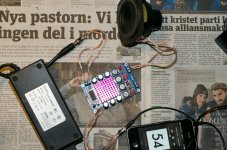Hi!
I am having problems with my ebay board amp (TK2050). I'm not getting any sound out of it at all. This is my second identical unit. I thought that the first one was broken so I ordered another one. Unfortunately I have the same problem with this one.
*I know that I'm getting power from the wires from the power supply (24V 5A DC)
*I know I'm getting signal from the wires from the iPhone
*I know that the speaker works
See attached photo.
I would be very grateful for any tips on what I'm doing wrong (if anything).
I'm starting to loose my mind here😡
I am having problems with my ebay board amp (TK2050). I'm not getting any sound out of it at all. This is my second identical unit. I thought that the first one was broken so I ordered another one. Unfortunately I have the same problem with this one.
*I know that I'm getting power from the wires from the power supply (24V 5A DC)
*I know I'm getting signal from the wires from the iPhone
*I know that the speaker works
See attached photo.
I would be very grateful for any tips on what I'm doing wrong (if anything).
I'm starting to loose my mind here😡
Attachments
It is rare, that two boards have the same errors. Can you hear any noise from the speaker? If not, check the right PS polarity, or change the cable between the iPhoe to board. Can you measure any voltage on board?
Thank you for your reply.
Sometimes when I connect the power I hear a low short sparkle from the speaker. Not every time though. With the first amp, I never heard anything.
I have measured the polarity of the power wires to the board so they should be right. Can I break the board if I connect them wrong?
I can borrow a multimeter to measure on the board but I don't have it right now.
Sometimes when I connect the power I hear a low short sparkle from the speaker. Not every time though. With the first amp, I never heard anything.
I have measured the polarity of the power wires to the board so they should be right. Can I break the board if I connect them wrong?
I can borrow a multimeter to measure on the board but I don't have it right now.
"This page may have moved or is no longer available"
This is similar or same:
TK2050 50W 50W 2X50W Class T HiFi Stereo Audio Amplifier Board | eBay
"Over/under voltage turn off" - measure the PS voltage, if you can.
This is similar or same:
TK2050 50W 50W 2X50W Class T HiFi Stereo Audio Amplifier Board | eBay
"Over/under voltage turn off" - measure the PS voltage, if you can.
If you have a 12V accu try to connect to board. It has good enough voltage to drive the amp, so you can identify a possible problem with PS.
I'm getting the same message with your link. "This page may have moved or is no longer available." But yeah, when I search ebay for that string, it looks like the exact same board from the same seller.
I will measure the PS but the board should work with 10-30V. I've got 24V.
I will measure the PS but the board should work with 10-30V. I've got 24V.
Yes, I've done that. Wrote aproximatly the same info to him as in post #1. Waiting for a reply.
Thanks for your efforts egra. Let me know if you think of something else.
Thanks for your efforts egra. Let me know if you think of something else.
I have measured the polarity of the power wires to the board so they should be right. Can I break the board if I connect them wrong?
Yes that will usually kill a class d IC.
You have to get it right first time.
Ok, thank you. There is a small possibility that that could have happened with the first board, but not with the second one when i measured the polarity.
some of the class D will fry instantly if you feed an input signal with the amp off (sure class D will do this)
Good thing they are "cheap"
Good thing they are "cheap"
If you don't connect a speaker then you have a series LC circuit on the output.
Applying a square wave to this will see across the L and C a voltage much higher than the power supply rails due to the voltages across L and C being 180 degrees out of phase.
If your LC capacitor is only rated at the supply rail voltage it will quickly fry.
Better explanation here:
http://amrita.vlab.co.in/?sub=1&brch=75&sim=326&cnt=1
Applying a square wave to this will see across the L and C a voltage much higher than the power supply rails due to the voltages across L and C being 180 degrees out of phase.
If your LC capacitor is only rated at the supply rail voltage it will quickly fry.
Better explanation here:
http://amrita.vlab.co.in/?sub=1&brch=75&sim=326&cnt=1
- Status
- Not open for further replies.
- Home
- Amplifiers
- Class D
- Problem with board amp
